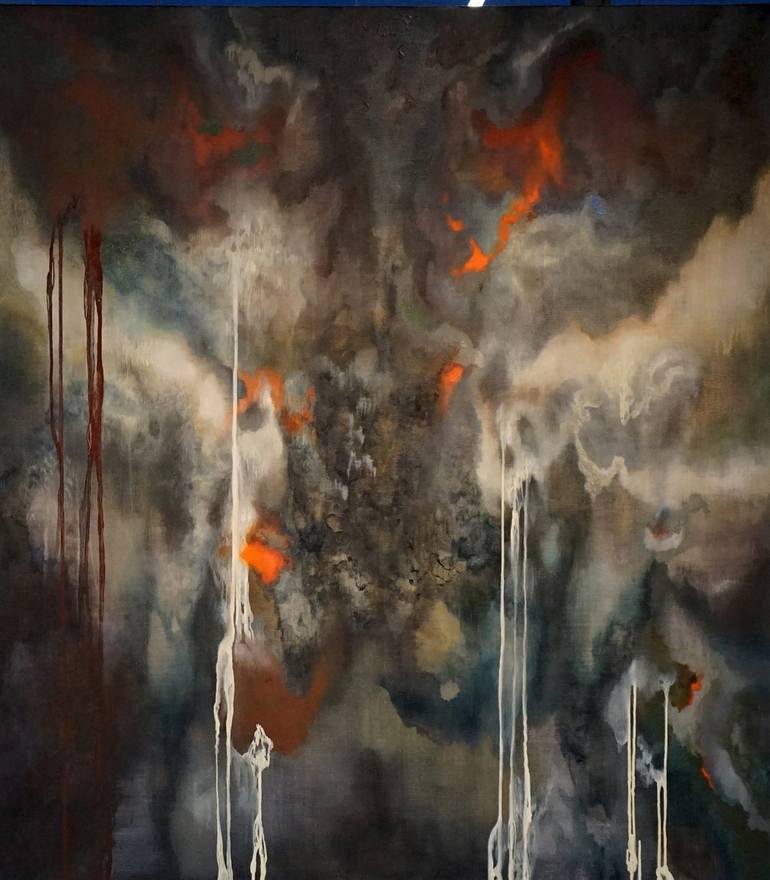




VIEW IN MY ROOM
lava SOLD Painting
Poland
Painting, Oil on Canvas
Size: 51.2 W x 59.1 H x 0.8 D in
Ships in a Crate
Artist Recognition

Artist featured in a collection
About The Artwork
I have divided my PhD thesis into a few stages. I show the subject of the ‚Przy-widzenie’ (in Polish, a pun on phantasm) in different ways, considering various aspects of the problem. However, I have made no attempt to give unequivocal answers. To begin with, there is the question of the diversity of the sensory perception of the world by various organisms. Research into this field is carried out by scientists (ethologists), who I was in contact with and with whom I consulted on the veracity of information I gained from various sources. I am also interested in the differences in perception between differing civilizations, ergo the anthropological context of the topic. I concentrate on physical anthropology and on the differences between people from different cultures in the evolution of the senses. The first canvases of the cycle correlate with synthetic thinking and with science, from which they are clearly derived. From here, the questions arise: Is it possible to find unity in a world full of diversity? Can Art be a means of seeking this unity? I was curious to see if I would manage to verify, to make objective, my own way of seeing. To a certain extent, to free myself from Eurocentrism. Cognitive science, anthropology, psychology, neurology and other scientific fields show that the mind of the man demonstrates a clear tendency to falsify reality by imposing design, by addition or by the reduction of inconvenient data. We even sometimes do not know the reasons for our own actions. Often we give an explanation after the fact, justifying ourselves out of uncertainty. To paraphrase the poet: How to cure oneself of the look which sees, but does not penetrate? Can visual art (paradoxically) liberate us from the excess of visual stimuli? Can art help us to develop or to discover an attitude of distance to the images which attack and dazzle man (particularly in a culture dominated by the mass media)? Seeking new ways of depiction can correlate with other spheres of life. For example, it can refer to the desire of the eyes – their tendency to become enslaved to the external image. It sometimes happens that there is kind of vector, reminding us of the peculiarity of being and the world. I would not be concerned with the subject of the Phantasm and most probably I would not create art if it did not give me the possibility to avoid superficiality, which is the result of habit, cliche, ready replies, and banalities. As the work progressing, imagination grows much more important than knowledge. Images spang out of images, giving birth to new meanings. Some images are connected to the perception of the child and memories of childhood. The beginning often turns out to be most important. Other images are connected to emotions, anxiety, or the fear associated with the uncertainty of vision. These anxieties reach very deep, but not necessarily to dark places. They are deeply rooted in man and are associated with the tragic impossibility of finding the truth. Man is restricted by the limitations of his senses and he becomes entangled in the illusions and errors of his mind. Anxiety wells up in him at the imponderable end of human life, at the apparent end of thinking and feeling.
Details & Dimensions
Painting:Oil on Canvas
Original:One-of-a-kind Artwork
Size:51.2 W x 59.1 H x 0.8 D in
Frame:Not Framed
Ready to Hang:Not applicable
Packaging:Ships in a Crate
Shipping & Returns
Delivery Time:Typically 5-7 business days for domestic shipments, 10-14 business days for international shipments.
Handling:Ships in a wooden crate for additional protection of heavy or oversized artworks. Crated works are subject to an $80 care and handling fee. Artists are responsible for packaging and adhering to Saatchi Art’s packaging guidelines.
Ships From:Poland.
Customs:Shipments from Poland may experience delays due to country's regulations for exporting valuable artworks.
Have additional questions?
Please visit our help section or contact us.
“I am delighted by this exhibition. It displays a rare sense of beauty, the drama of the world and man's place in it. The paintings are technically bold and highly accomplished (...). It's a very pleasant surprise for me that something like this Is So close. There's a huge sense of drama and tension in the work and a great question mark regarding human existence. Also, a very dynamic organisation of space ... the images are superb" Prof. Andrzej Strumiłło about „The desert” project Aleksandra Batura (b.1982) a Warsaw based artist and mother of two sons. Aleksandra does easel painting. She has undertaken numerous video projects, experimented with painting and drawing techniques as well as designed and completed several mural paintings. Her work can be found in national and international collections.
Artist Recognition

Artist featured by Saatchi Art in a collection
Thousands Of Five-Star Reviews
We deliver world-class customer service to all of our art buyers.
Global Selection
Explore an unparalleled artwork selection by artists from around the world.
Satisfaction Guaranteed
Our 14-day satisfaction guarantee allows you to buy with confidence.
Support An Artist With Every Purchase
We pay our artists more on every sale than other galleries.
Need More Help?